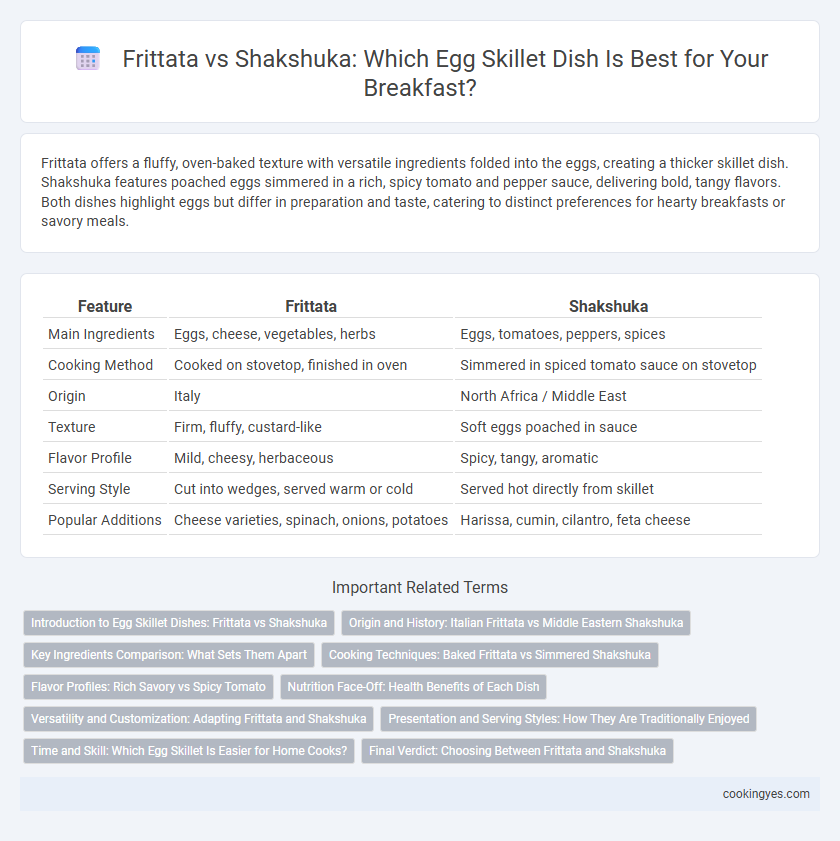Frittata offers a fluffy, oven-baked texture with versatile ingredients folded into the eggs, creating a thicker skillet dish. Shakshuka features poached eggs simmered in a rich, spicy tomato and pepper sauce, delivering bold, tangy flavors. Both dishes highlight eggs but differ in preparation and taste, catering to distinct preferences for hearty breakfasts or savory meals.
Table of Comparison
| Feature | Frittata | Shakshuka |
|---|---|---|
| Main Ingredients | Eggs, cheese, vegetables, herbs | Eggs, tomatoes, peppers, spices |
| Cooking Method | Cooked on stovetop, finished in oven | Simmered in spiced tomato sauce on stovetop |
| Origin | Italy | North Africa / Middle East |
| Texture | Firm, fluffy, custard-like | Soft eggs poached in sauce |
| Flavor Profile | Mild, cheesy, herbaceous | Spicy, tangy, aromatic |
| Serving Style | Cut into wedges, served warm or cold | Served hot directly from skillet |
| Popular Additions | Cheese varieties, spinach, onions, potatoes | Harissa, cumin, cilantro, feta cheese |
Introduction to Egg Skillet Dishes: Frittata vs Shakshuka
Frittata and shakshuka are popular egg skillet dishes that showcase different culinary traditions and flavors. Frittata, an Italian specialty, features beaten eggs mixed with ingredients like cheese, vegetables, and meats, cooked slowly and finished under a broiler for a fluffy texture. Shakshuka, a North African and Middle Eastern dish, consists of eggs poached in a spicy, tangy tomato and pepper sauce, offering a robust, savory taste profile.
Origin and History: Italian Frittata vs Middle Eastern Shakshuka
Frittata, rooted in Italian cuisine, dates back to ancient Rome as a versatile egg-based dish often enriched with vegetables, cheese, and meats, reflecting regional variations across Italy. In contrast, Shakshuka originated in North Africa and gained widespread popularity in Middle Eastern countries, particularly Israel, featuring poached eggs in a spiced tomato and pepper sauce that highlights Mediterranean and Arab culinary influences. Both dishes showcase rich cultural histories, with Frittata emphasizing Italian tradition and Shakshuka exemplifying Middle Eastern and North African flavors.
Key Ingredients Comparison: What Sets Them Apart
Frittata primarily features eggs mixed with a variety of fillings such as cheese, vegetables, and cured meats, cooked slowly on the stovetop and finished in the oven. Shakshuka centers on eggs poached in a spiced tomato and pepper sauce, incorporating ingredients like garlic, cumin, and chili peppers that create a rich, tangy base. The key distinction lies in the frittata's dense, blended texture versus shakshuka's saucy, savory tomato foundation.
Cooking Techniques: Baked Frittata vs Simmered Shakshuka
Frittata is cooked primarily by baking or finishing on the stovetop to achieve a firm, custard-like texture, while shakshuka involves simmering eggs in a spiced tomato and pepper sauce until they gently poach. The baked frittata requires even heat distribution in an oven or covered skillet to set the eggs uniformly without curdling. In contrast, shakshuka's cooking technique emphasizes slow simmering to allow the sauce flavors to meld and eggs to cook softly within the sauce matrix.
Flavor Profiles: Rich Savory vs Spicy Tomato
Frittata features a rich, savory flavor profile characterized by creamy eggs blended with cheese, herbs, and vegetables, creating a hearty and comforting skillet dish. Shakshuka offers a contrasting taste with its bold, spicy tomato base infused with garlic, cumin, and chili peppers, delivering a vibrant and tangy experience. The choice between Frittata and Shakshuka depends on preference for creamy, cheesy richness versus a zesty, spicy tomato aroma.
Nutrition Face-Off: Health Benefits of Each Dish
Frittata offers a high-protein, nutrient-dense option rich in vitamins A, D, and B12 due to its inclusion of eggs and often vegetables or cheese. Shakshuka provides a lower-calorie alternative with antioxidants from tomatoes and bell peppers, plus vitamin C and lycopene for cardiovascular benefits. Both dishes support heart health and weight management but differ in macronutrient composition and antioxidant profiles.
Versatility and Customization: Adapting Frittata and Shakshuka
Frittatas offer greater versatility and customization due to their adaptable base of beaten eggs combined with a wide range of ingredients like vegetables, cheeses, and meats, allowing for diverse flavor profiles and textures. Shakshuka, a poached egg dish in a spicy tomato sauce, tends to have a more fixed flavor profile rooted in Middle Eastern and North African spices but can be adjusted by varying peppers, chilies, and herbs. Both dishes excel in customization, but frittatas provide a broader canvas for ingredient substitution and cooking techniques.
Presentation and Serving Styles: How They Are Traditionally Enjoyed
Frittatas are traditionally served sliced like a pie, often warm or at room temperature, showcasing a dense, custardy texture with visible layers of vegetables, cheese, or meats baked inside. Shakshuka is presented directly in the skillet, with poached eggs nestled in a rich, spiced tomato sauce, emphasizing a rustic, communal dining experience often accompanied by crusty bread for dipping. The presentation styles highlight the frittata's structured, sliceable form versus shakshuka's vibrant, sauce-drenched, and spoonable appeal.
Time and Skill: Which Egg Skillet Is Easier for Home Cooks?
Frittata requires less active cooking time and is simpler to prepare, making it ideal for home cooks with basic culinary skills. Shakshuka involves simmering a rich tomato sauce with spices before gently poaching eggs, which takes longer and demands more attention to prevent overcooking. Home cooks seeking a quick, straightforward egg skillet dish should opt for frittata due to its ease and faster preparation time.
Final Verdict: Choosing Between Frittata and Shakshuka
Frittata and shakshuka both offer rich, flavorful options for egg skillet dishes, with frittata providing a versatile, baked combination of eggs, cheese, and vegetables, ideal for customizable meals and make-ahead options. Shakshuka emphasizes a savory, spiced tomato base with poached eggs, delivering a vibrant, Middle Eastern-inspired dish rich in antioxidants and bold flavors. Choosing between frittata and shakshuka depends on preference for texture and flavor profiles: creamy, layered textures suit frittata enthusiasts, while those craving tangy, spiced tomato richness prefer shakshuka.
Frittata vs Shakshuka for egg skillet dishes Infographic

 cookingyes.com
cookingyes.com